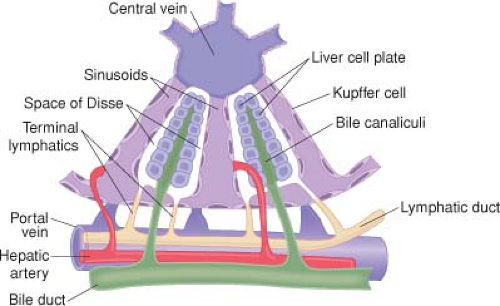The Liver: Surgery and Anesthesia
The liver is the largest internal organ and is the body’s metabolic headquarters (Table 45-1 and Fig. 45-1) (Steadman RH, Braunfeld MY. The liver: surgery and anesthesia. In: Barash PG, Cullen BF, Stoelting RK, Cahalan MK, Ortega R, Stock MC, eds. Clinical Anesthesia. Philadelphia: Lippincott Williams & Wilkins; 2013:1294–1325).
III. Liver Biopsy
Liver biopsy is the method of choice to determine whether liver damage is due to necrosis, inflammation, steatosis, or fibrosis (coagulopathy or thrombocytopenia contraindicates percutaneous liver biopsy).
IV. Hepatic and Hepatobiliary Diseases
Liver disease may be the result of a variety of causes, including developmental or genetic defects, metabolic abnormalities, autoimmune diseases, infectious diseases, neoplasm, alcohol, environmental toxins, and drug toxicity.
Liver disease can be divided into hepatocellular (parenchymal) or biliary. In hepatocellular diseases, evidence of cholestasis and synthetic dysfunction appear synchronously.
Liver disease may also be described as acute (drug toxicity, infection) or chronic (viral hepatitis, alcoholic liver disease, nonalcoholic fatty liver disease [NAFLD]). The most common causes of chronic liver disease are chronic viral hepatitis, alcoholic liver disease, and NAFLD. The most important consequences of chronic liver disease are portal hypertension, cirrhosis, and malignancy.
V. Acute Liver Failure
Acute liver failure (ALF) is defined as the appearance of encephalopathy together with coagulopathy, usually an international normalized ratio (INR) ≥1.5, in a patient who has no previous history of liver disease and who has had an illness of <26 weeks’ duration.
Drug-related toxicity accounts for more than half of the cases of ALF in the United States. Of these drug-related cases, more than 80% are the result of acetaminophen ingestion.
The natural history of adult ALF in the United States is one of spontaneous recovery in approximately 45% of patients, liver transplantation in 25%, and death without transplantation in 30%.
The most serious, and often the proximate cause of death, is acute cerebral edema and intracranial hypertension (Table 45-4).
Coagulopathy is a necessary finding for the diagnosis of ALF; however, clinically significant spontaneous bleeding is uncommon. Correction of thrombocytopenia to ≥50,000/mm3 and INR to ≤1.5 are suggested for the bleeding patient or the patient about to undergo an invasive procedure.
Hypotension in ALF may be the result of several days of gastrointestinal losses, poor intake, or myocardial dysfunction but likely includes a component of decreased arterial tone as liver necrosis progresses.
Vasopressors (norepinephrine, dopamine) may be used to treat either systemic hypotension or to maintain an adequate cerebral perfusion pressure.
The use of arginine vasopressin or its analogs cannot be recommended because there is evidence that their use is associated with increases in intrahepatic cholestasis of pregnancy (ICP).
Table 45-1 Hepatic Function in Health | |
|---|---|
|
Table 45-2 Blood Tests and the Differential Diagnosis of Hepatic Dysfunction | ||||||||||||||||||||||||||||||||
|---|---|---|---|---|---|---|---|---|---|---|---|---|---|---|---|---|---|---|---|---|---|---|---|---|---|---|---|---|---|---|---|---|
|
Table 45-3 Hepatobiliary Imaging | |
|---|---|
|
Table 45-4 General Measures to Reduce Cerebral Edema | |
|---|---|
|
VI. Acute Hepatitis
The most common causes of acute viral hepatitis are, collectively, the five identified viral hepatitides: A (HAV), B (HBV), C (HCV), D (HDV or delta-virus), and E (HEV).
HAV and HBV have been well characterized, and vaccines have been developed to prevent their transmission.
A vaccine is not available for HCV, but the number of reported new cases is decreasing most likely due to better screening of transfused blood products and the adoption of universal precautions.
The diagnosis of acute hepatitis is made on the basis of classic signs (jaundice, fever, arthralgia) and symptoms (may be nonspecific such as fatigue or poor appetite) together with laboratory studies. Many infections are subclinical.
Incubation periods can be several weeks to even months, and patients may undergo surgery without awareness of illness. For this reason, viral hepatitis should be part of the differential diagnosis when there is any evidence of postoperative liver injury.
VII. Alcoholic Hepatitis
Alcoholic hepatitis is the syndrome marked by the development of jaundice and liver dysfunction in the setting of heavy alcohol use.
VIII. Drug-Induced Liver Injury
Drug-induced liver injury (DILI) is largely a diagnosis of exclusion and should always be considered when formulating the differential diagnosis of patients presenting with liver abnormalities.
DILI is a serious problem for the pharmaceutical industry because it is the most common reason for regulatory actions such as failure of approval, removal from market, or restrictions on indications for use.
Nonacetaminophen drug-induced idiosyncratic liver injury accounts for 11% to 13% of cases of ALF, and with a 20% rate of survival with supportive care, it has a poorer than average rate of spontaneous recovery.
In anesthesiology, perhaps the best-known potentially hepatotoxic drug is halothane.
IX. Pregnancy-Related Liver Diseases
Abnormalities in liver studies occur in 3% to 5% of pregnancies
The most common causes are hyperemesis gravidarum, intrahepatic cholestasis of pregnancy, preeclampsia, preeclampsia complicated by hemolysis, low platelet count, and elevated liver enzymes (HELLP syndrome) and acute fatty liver of pregnancy (Table 45-5).
X. Cirrhosis and Portal Hypertension
Cirrhosis is the end product of the long course of chronic liver disease, during which there have been either steady or recurrent episodes of parenchymal inflammation and necrosis.
Increased resistance to blood flow through the liver leads to portal hypertension. When portal hypertension becomes severe (generally defined as a hepatic venous pressure gradient of >10–12 mm Hg), chronic liver disease becomes a systemic illness, affecting other organ systems as well.
Table 45-5 Distinguishing Features of Intrahepatic Cholestasis of Pregancy (ICP), Hellp Syndrome, and Acute Fatty Liver of Pregnancy (AFLP) | ||||||||||||||||||||||||
|---|---|---|---|---|---|---|---|---|---|---|---|---|---|---|---|---|---|---|---|---|---|---|---|---|
|










